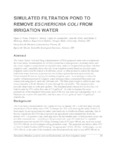Use este identificador para citar ou linkar para este item:
http://www.alice.cnptia.embrapa.br/alice/handle/doc/970584Registro completo de metadados
| Campo DC | Valor | Idioma |
|---|---|---|
| dc.contributor.author | ROSS, R. D. | pt_BR |
| dc.contributor.author | SHOCK, C. C. | pt_BR |
| dc.contributor.author | LAUBACHER, T. A. | pt_BR |
| dc.contributor.author | PINTO, J. M. | pt_BR |
| dc.contributor.author | MAHONY, A. C. | pt_BR |
| dc.date.accessioned | 2017-07-19T00:05:15Z | - |
| dc.date.available | 2017-07-19T00:05:15Z | - |
| dc.date.created | 2013-11-06 | pt_BR |
| dc.date.issued | 2013 | pt_BR |
| dc.identifier.citation | In: SHOCK, C. C. (Ed.). Preliminary studies on Escherichia coli and onion. Ontário: Oregon State University, Malheur Experiment Station, 2013. | pt_BR |
| dc.identifier.uri | http://www.alice.cnptia.embrapa.br/alice/handle/doc/970584 | pt_BR |
| dc.description | The United States Food and Drug Administration?s (FDA) proposed water rules to implement the Food Safety Modernization Act (FSMA) could leave some growers, especially those who rely on an irrigation system based on recycled water, unable to irrigate fresh produce with their irrigation water, especially those who rely on an irrigation system based on recycled water. Irrigation water could be treated with chlorine, ozone, or other product to reduce the bacterial load in the water; however, at present not one of these options has been approved by the Environmental Protection Agency for treating irrigation water. In an attempt to reduce the number of bacteria present in irrigation water entering a farm, a simulated filter pond was constructed using gravel, sand, and silt-loam soil. The filter pond sought to utilize in part what occurs naturally with the filtration of water through the soil profile. This natural process provides clean water in wells and aquifers. The simulated pond reduced the Escherichia coli load in water by 95% with a flow rate of 3.9 gal/h/yd2. In order to increase the water productivity of the simulated filter pond, most of the dirt was removed; subsequently the E. coli filtration rate went to 55% and 46%, with flow rates of 12.9 gal/h/yd2 and 17.6 gal/h/yd2, respectively. | pt_BR |
| dc.language.iso | eng | eng |
| dc.relation.ispartofseries | (OSU. Special Report, Ext/CrS, 148). | pt_BR |
| dc.rights | openAccess | eng |
| dc.subject | Onion | pt_BR |
| dc.title | Simulated filtration pond to remove Escherichia coli from irrigation water. | pt_BR |
| dc.type | Parte de livro | pt_BR |
| dc.date.updated | 2017-07-19T00:05:15Z | pt_BR |
| dc.subject.thesagro | Cebola | pt_BR |
| dc.subject.thesagro | Irrigação | pt_BR |
| dc.subject.thesagro | Allium Cepa | pt_BR |
| dc.subject.thesagro | Bactéria | pt_BR |
| dc.subject.thesagro | Escherichia Coli | pt_BR |
| dc.format.extent2 | p. 36-42. | pt_BR |
| riaa.ainfo.id | 970584 | pt_BR |
| riaa.ainfo.lastupdate | 2017-07-18 | pt_BR |
| dc.contributor.institution | JOSE MARIA PINTO, CPATSA. | pt_BR |
| Aparece nas coleções: | Capítulo em livro científico (CPATSA)  | |
Arquivos associados a este item:
| Arquivo | Descrição | Tamanho | Formato | |
|---|---|---|---|---|
| Pinto4.pdf | 134,63 kB | Adobe PDF |  Visualizar/Abrir |









